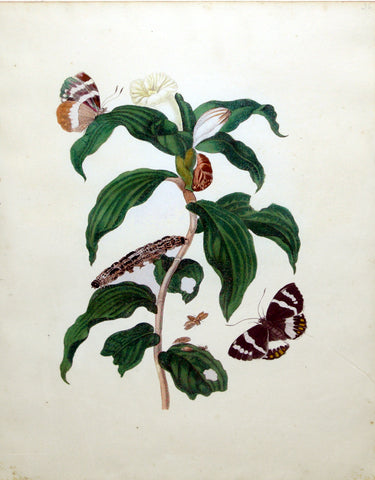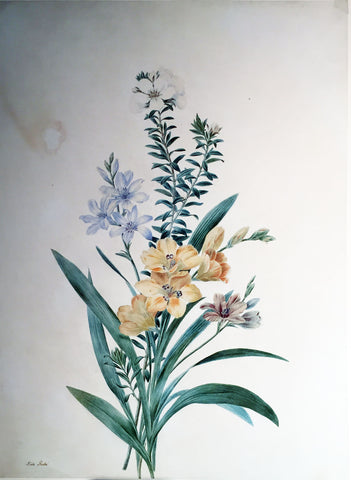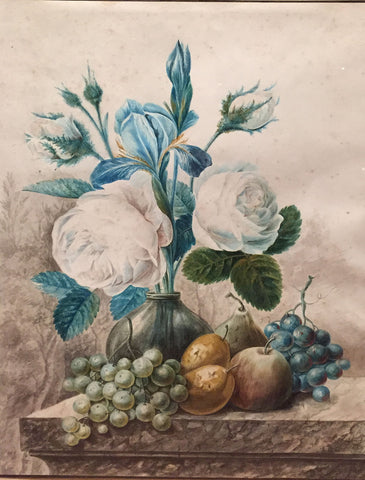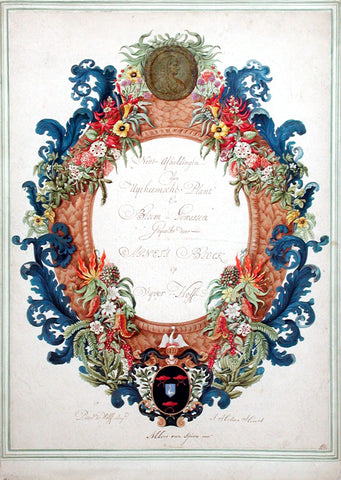
Maria Sibylla Merian (German, 1647-1717), Plate 36. The Two Lepidopters of Castnia (Castnia evalthoides) on a Tobacco Plant
Maria Sibylla Merian (German, 1647-1717)
“Plate 36. The Two Lepidopters of Castnia (Castnia evalthoides) on a Tobacco Plant”
from The Insects of Surinam
Watercolor and bodycolor with gum arabic over lightly etched outlines on paper
Amsterdam, 1705
Paper size: 20 1/4 x 14 in.
Transfer-print watercolors from The Insects of Surinam
In Merian’s text entry for this plate, she chronicles finding the tobacco plant that she observed for this plate growing in the forest of Surinam. Due to the heat the plant wilted, so Merian had an Indian dig the “very white root of the Tobacco” and take it to the garden by her house. There it bloomed successfully, producing a single white blossom that resembled the flower of a Tuberose. It bloomed again six months later. On April 14, 1701, she discovered a white, brown and black caterpillar eating the leaves of the Tobacco plant, noting that it became a brown and white butterfly with orange-yellow hind wings on April 26. She also found a cocoon on the first of April from which the hovering fly emerged ten days later.
She also depicted the upper and underside of the moth, Telchin licus (Drury), which she thought was a butterfly. This family of moths has unusual pointed antennae and bright coloration which can lead to this confusion. The larva which Merian described as “a caterpillar embellished with black and white flecks “ is probably another species.
Descriptions of each plant adapted from J.Harvey’s commentary to the Folio Society facsimile of the Surinam Album (London, 2006) and Merian’s text for the Insects of Surinam.
One glimpse of any of Merian’s transfer-print watercolors from the Insects of Surinam reveals the main reasons for such celebration. Even to those who do not know of her work, this is a stunning sight. Her colors are alternately subtle and vibrant, capturing the quality of her subjects with striking naturalism. Yet while she maintains a scientist’s eye for precision, her creative decisions and compositions give these images a style that is distinctly hers. Each image demonstrates Merian’s masterful grasp of detail and nuance, as well as her outstanding ability to combine science and art. Equally significant, to early 18th century Europeans, her illustrations represented the first views of these American plants and insects.
These spectacular examples of her work are from one of a very few transfer-print watercolor volumes known to exist. Merian herself prepared the volume. After an uncolored print was made, she applied dampened paper to it, pressing by hand to create an image of the print in reverse. In this volume, she chose to block out the plate numbers and then add by hand, to some images, numbers, and notations. Merian then painstakingly watercolored the dried paper herself, ensuring that the colors were true to the specimens she had seen in South America, and also allowing her style to emerge with the greatest clarity. The volume was not meant for sale, and its intended purpose cannot be known with any certainty. Perhaps it was created as a gift for a wealthy and important patron, perhaps Merian meant to keep it herself. What can be stated without a doubt is that these splendid images represent a unique opportunity to acquire original works by an artist who broke barriers as a woman, as a scientist and artist, and whose accomplishments are no less impressive today than they were in her time.
Please feel free to contact us with questions by phone at 215.735.8811,
or by email at loricohen@aradergalleries.
We Also Recommend





